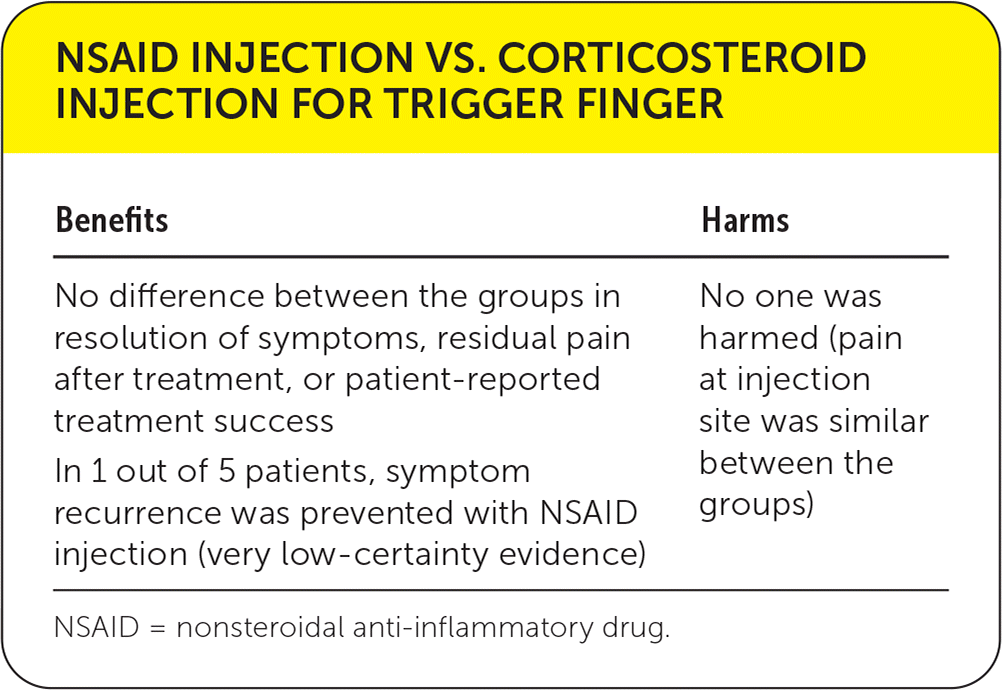
Am Fam Physician. 2021;104(5):online
Author disclosure: No relevant financial affiliations.

Details for This Review
Efficacy End Points: Resolution of symptoms, continued moderate to severe symptoms, recurrence of symptoms 12 to 24 weeks after treatment; total active finger motion after treatment; residual pain after treatment; patient-reported treatment success
Harm End Points: Adverse events 12 to 24 weeks after treatment (e.g., pain at the injection site)
Narrative: Trigger finger is a common condition caused by abnormal movement of an inflamed, thickened, or swollen flexor tendon as it glides within its tendon sheath through the first annular pulley, which may also be narrow due to thickening.1,3 Trigger finger can lead to pain, catching, or locking of the affected digit. Management is typically conservative, including rest, immobilization, and oral and topical nonsteroidal anti-inflammatory drugs (NSAIDs).1,3

| Benefits | Harms |
|---|---|
| No difference between the groups in resolution of symptoms, residual pain after treatment, or patient-reported treatment success | No one was harmed (pain at injection site was similar between the groups) |
| In 1 out of 5 patients, symptom recurrence was prevented with NSAID injection (very low-certainty evidence) |
Corticosteroid injections are usually implemented when conservative management is not effective or function is impaired.1,3 Although effective, corticosteroid injections may cause unwanted adverse effects, such as fat atrophy and hypopigmentation of the skin and elevated blood glucose levels in patients with diabetes mellitus.4–6 An injectable NSAID at the level of the first annular pulley could avoid these adverse effects and may be more effective in treating trigger finger.
The Cochrane review included two randomized controlled trials with 231 total patients (average age = 59 years; 60% female) from Singapore and Malaysia in outpatient settings. The trials compared NSAID injection (12.5-mg diclofenac or 15-mg ketorolac) with corticosteroid injection (5-mg or 20-mg triamcinolone acetonide).
The systematic review and meta-analysis showed that NSAID injections offered little to no additional relief from trigger finger symptoms, with a trend toward persistent moderate to severe symptoms, compared with corticosteroid injections at 12 to 24 weeks. Although the data suggest that NSAID injections have a small benefit over corticosteroid injections for preventing recurrence of symptoms (relative risk reduction = 0.93; 95% CI, 0.62 to 0.99; absolute risk reduction = 20%; number needed to treat = 5), the certainty of the evidence is very low because of study bias and imprecision.
The degree of benefit, if any, is uncertain. Trends suggested an improvement in active range of motion with corticosteroid injections; however, the findings were not clinically significant. No statistically significant findings showed that NSAID injections were superior to corticosteroid injections for the resolution of symptoms or residual pain, and NSAIDs did not improve patient-reported treatment success relative to corticosteroids. There were few adverse effects (e.g., pain at the injection site) reported in either group, and no statistical difference was noted.
Caveats: The Cochrane review had several limitations. Only two small studies met the criteria for inclusion, and the risk of bias was high in both studies because of incomplete outcome data, selection bias, and an unclear risk of performance bias in blinding personnel and participants. This made the certainty of evidence low to very low for all outcomes. There was further potential bias because two of the review authors also authored one of the included studies. Attempts to counter potential bias included arranging a third-party analysis of the risk of bias and an independent methodologist's review of critical steps.
The two studies used doses of NSAIDs that were lower than typically used in injections for other musculoskeletal conditions.1 The same corticosteroid (triamcinolone) was used in both studies but at different doses, which could have affected comparisons and pooling of outcomes because a dose-response relationship has been shown in the six months following triamcinolone injections for the treatment of trigger finger.7 Both studies were conducted in orthopedic clinics, limiting their generalizability to family medicine.
Conclusion: We have assigned a color recommendation of yellow (unclear benefits) for this intervention because of the lack of conclusive data. A noninferiority study could be more beneficial in comparing the use of NSAID injection with corticosteroid injection than those conducted with a superiority hypothesis.
The views expressed in this material are those of the authors and do not reflect the official policy or position of the U.S. government, the Department of Defense, the Department of the Air Force, or the Uniformed Services University of the Health Sciences.
